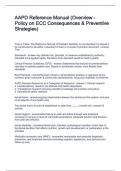AAPD Reference Manual (Overview -
Policy on ECC Consequences & Preventive
Strategies)
True or False: The Reference Manual of Pediatric Dentistry is not intended nor should it
be constructed to be either a standard of care or a scope of practice document - answer
True
Standards - answer any definite rule, principle, or measure established by authority.
Intended to be applied rigidly. Deviation from standard would be hard to justify
Clinical Practice Guidelines (CPG) - answer Statements that include recommendations
intended to optimize patient care. Based on systematic review; more flexible than
standards
Best Practices - answerthe best clinical or administrative practice or approach at the
moment, given consumer & community needs/desires, resources available, & evidence
AAPD Devotes Resources to 4 Categories of Research - answer1. Clinical research
2. Interdisciplinary research (to address oral health disparities)
3. Translational research (moving scientific knowledge into practice and policy)
4. Operational safety research
dental home - answerongoing relationship between the dentist and the patient, inclusive
of all aspects of oral health care
The dental home should be established no later than _____ months old - answer12
months
dental neglect - answerwillful failure to seek and follow through with treatment
necessary to ensure a level of oral heath essential for adequate function and freedom
from pain and infection
dental disability - answerorofacial pain, infection, pathological condition and/or lack of
functional dentition that affects nutrition, growth and development, or participation in life
activities
Medically-necessary care (MNC) - answerthe reasonable and essential diagnostic,
preventive, and treatment services (including supplies, appliances, and devices) and
follow-up care
,includes use of supportive health care services necessary like GA, sedation
Special health care needs include - answerany physical, developmental, mental,
sensory, behavioral, cognitive, or emotional impairment or limiting condition that
requires medical management, health care intervention, and/or use of specialized
services or programs.
_____ % of children experience caries in primary teeth by 5 yrs old - answer60%
By 17 yrs old _____% of children in the U.S. have experienced caries - answer78%
As much as _____% of all caries in school-aged children occurs in pits and fissures -
answer90%
Which disease is associated with insufficient development in children who have no other
medical problems? - answerrampant caries
periodontal disease is associated with - answerCVD & adverse pregnancy outcomes,
including pregnancy HTN
T or F: An association between oral health and respiratory diseases has been
recognized. Oral health, oral microflora, and bacterial pneumonia, especially in
populations at high risk for respiratory disease, have been linked. - answerTrue
dental plaque may serve as a reservoir for respiratory pathogens in patients who are
undergoing _____________________ - answermechanical ventilation
Food preferences appear to be established early, probably by ____ months old -
answer12 months
Children experiencing caries as infants and toddlers have a much greater probability of
subsequent caries in:
- primary dentition?
- permanent dentition?
- both? - answerboth (primary and permanent dentitions)
Which restorations are less likely than other restorations to require retreatment? -
answerSSCs
A child who receives sealants is _____% less likely to receive restorative services over
the next 3 yrs than children who do not - answer72 %
With follow-up care, the success rate of sealants may be ____ - ____% even after a
decade - answer80 - 90 %
, Sealants are safe and effective, yet their use continues to be _______ - answerlow
The impact of chronic conditions (CC) status and CC severity increases the odds of
receiving dental treatment under ________ - answergeneral anesthesia
GA, under certain circumstances, may offer a cost-saving alternative to ________ for
children with ECC - answersedation
The World Health Organization defines social determinants of health as ____________
- answerthe conditions in which people are born, grow, work, live, and age, and the
wider set of forces and systems shaping the conditions of daily life
health equity - answerthe fair and just opportunity to be as healthy as possible - requires
elimination of those societal factors that unfairly result in poorer health for at-risk social
groups
T or F: The same SDH that affect a caregiver's oral health outcomes also affect his
children's oral health directly and indirectly. - answerTrue
Children living in settings with multiple social risks are at substantially greater risk for
__________ - answercaries
SDH may be reflected by what 3 things? - answer- a heavy allostatic load
(biologicalmarkers of chronic stress)
- poor oral health behaviors
- higher caries rates
adverse association exists between - answer- socioenvironmental stressors
- neuroendocrine factors
- levels of intraoral cariogenic bacteria in children
chronic stress associated with SES leads to negative physiologic effects on oral health
including: - answerpro-inflammatory, endocrine & microbiological responses
Neighborhood income is positively associated with - answerimproved oral hygiene
practices & lower dental disease levels for children
social capital - answersocial support, social networks & social cohesion
- Studies generally have reported positive health outcomes associated with greater
levels of social capital
-social capital is beneficial, but social norms can influence the way in which resources
are deployed, which can lead to suboptimal oral health behaviors and poor outcomes.




